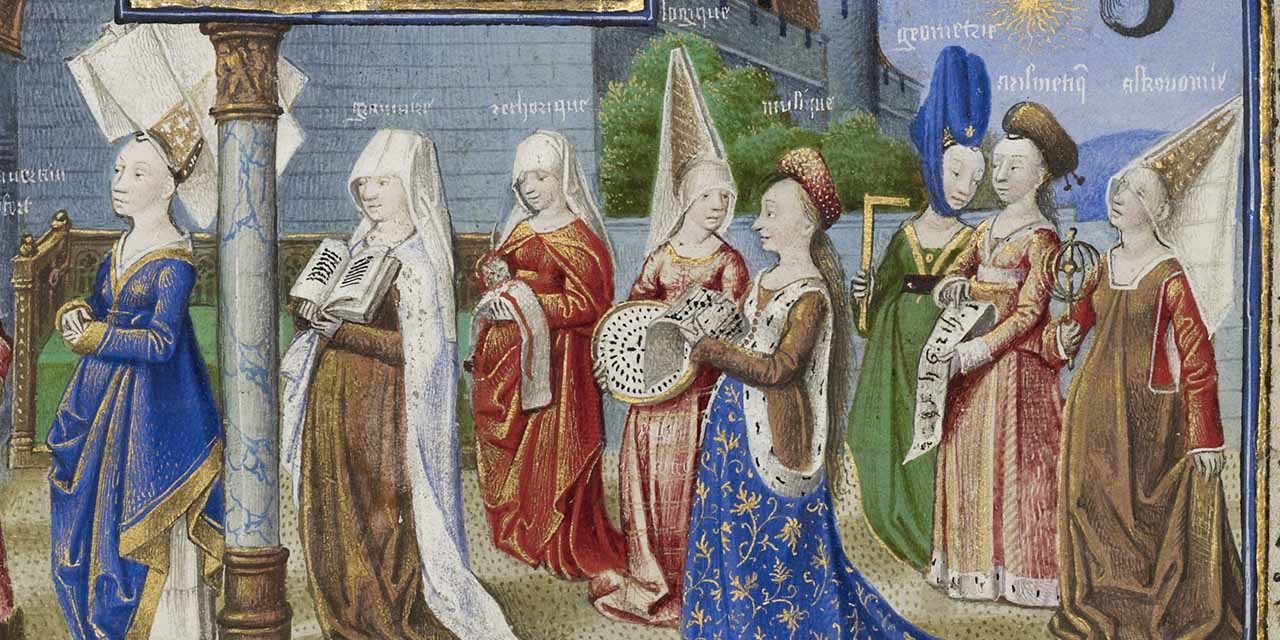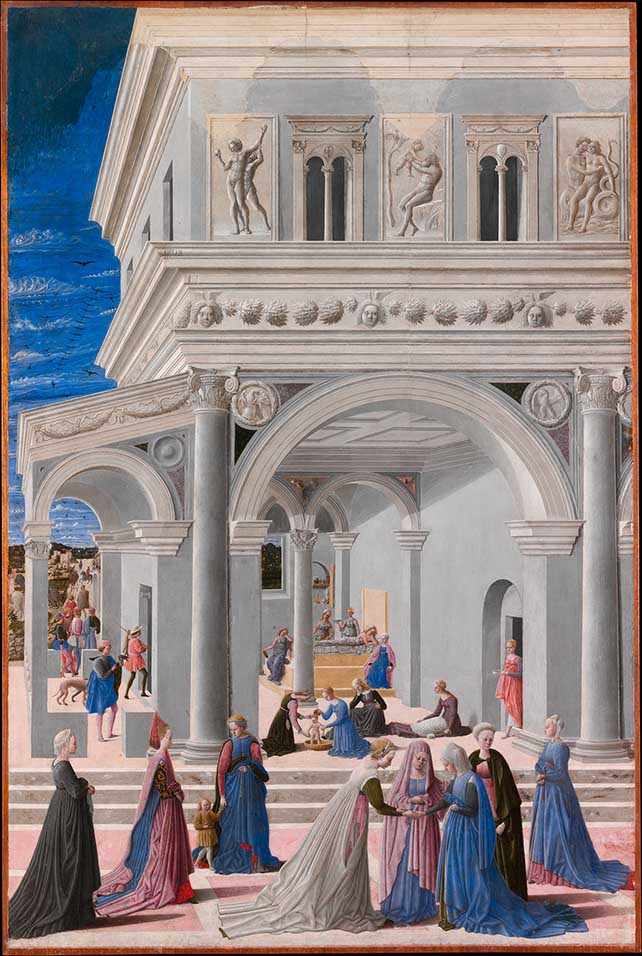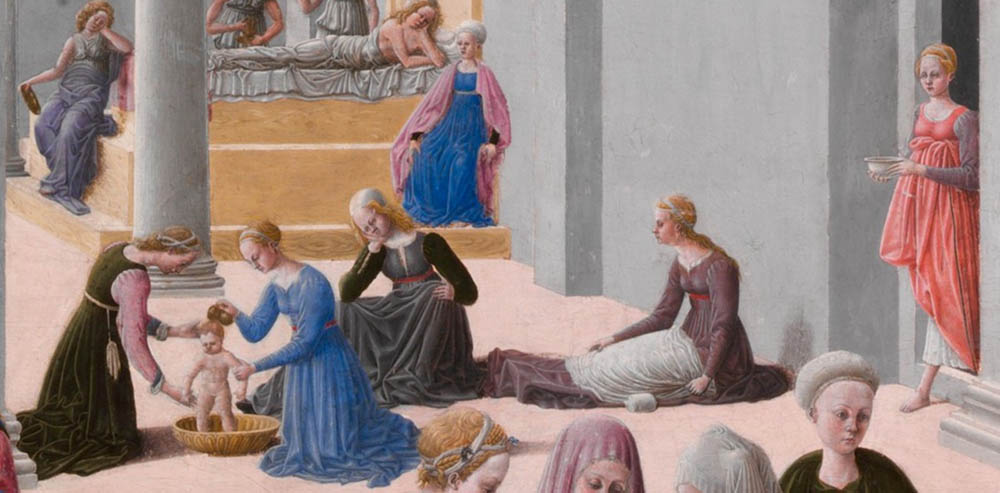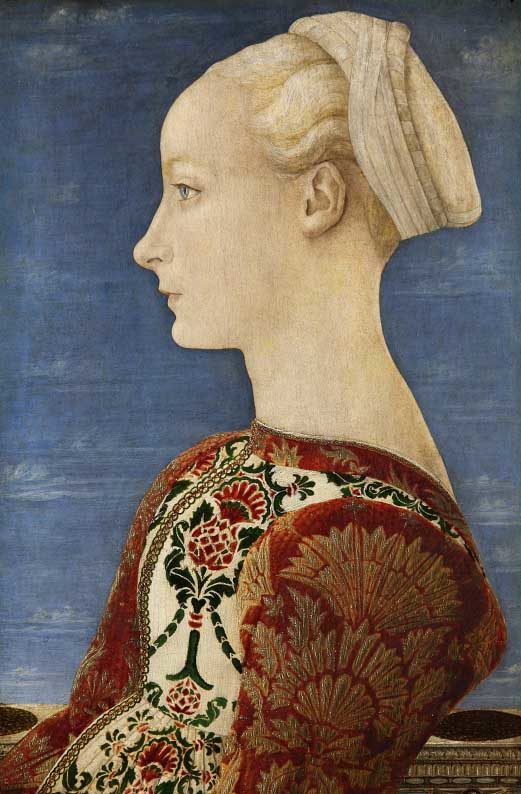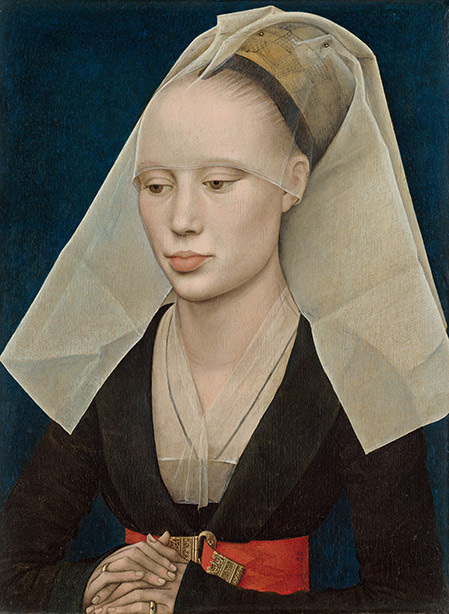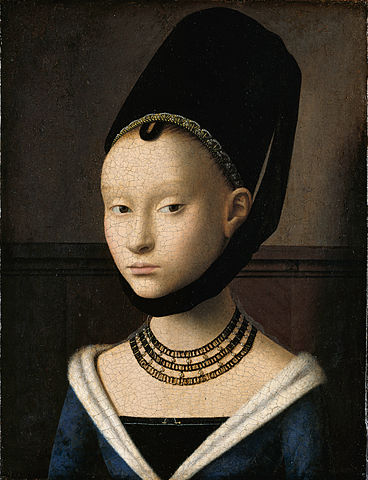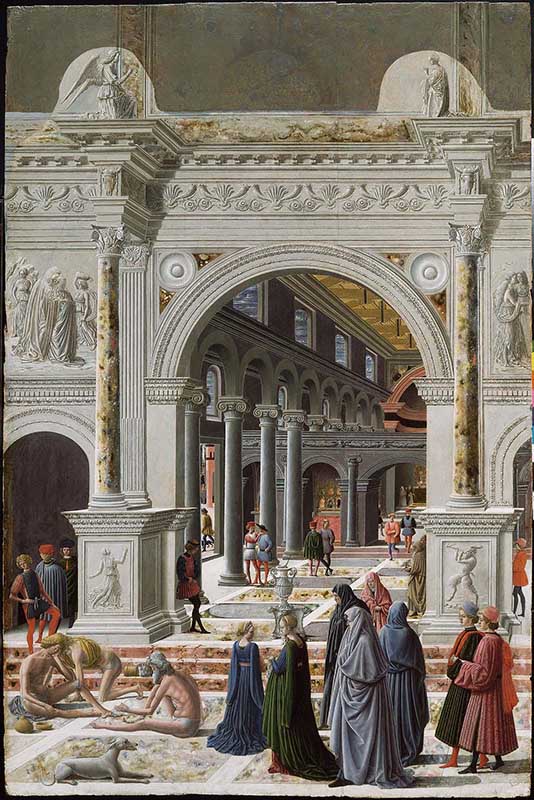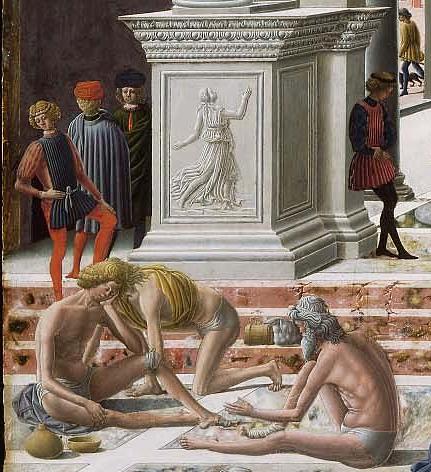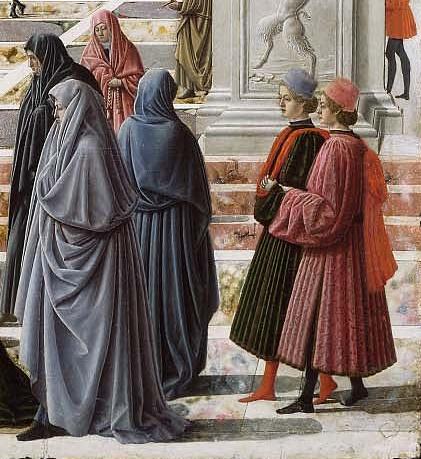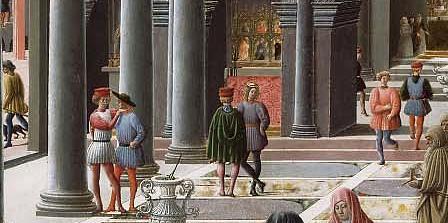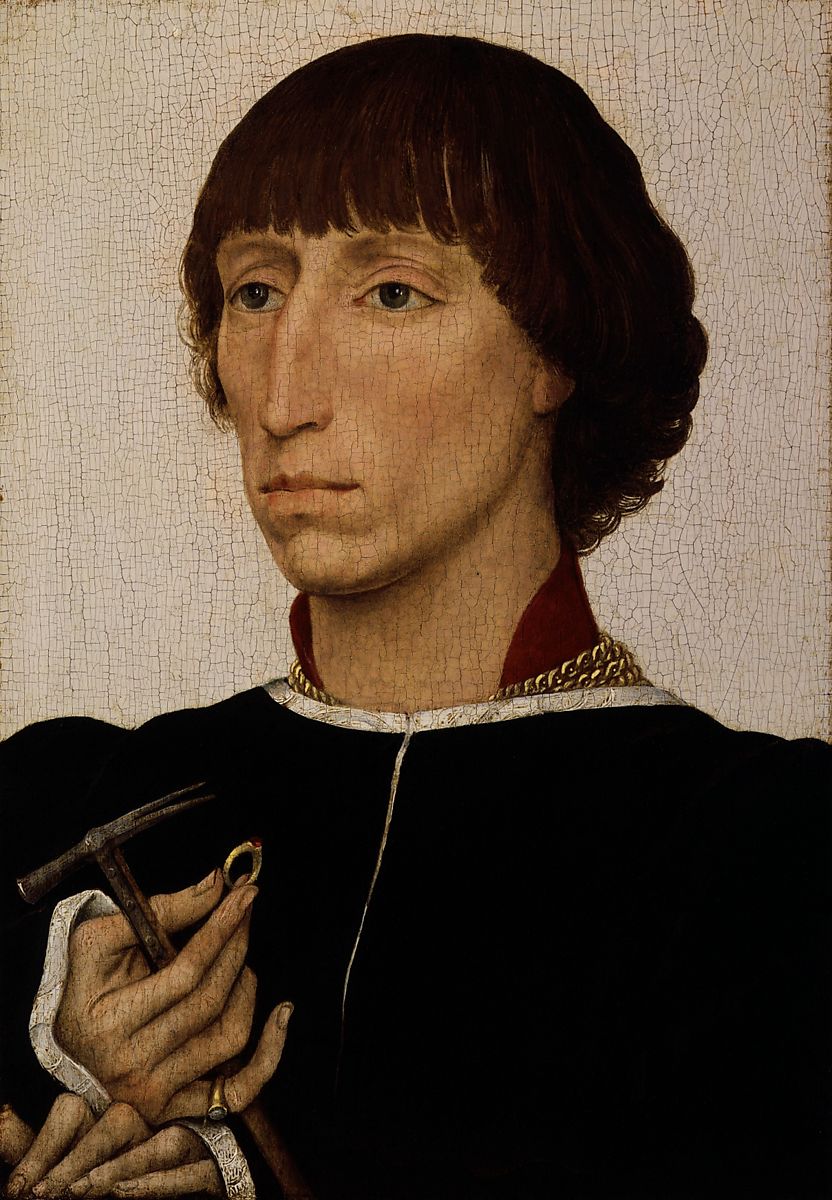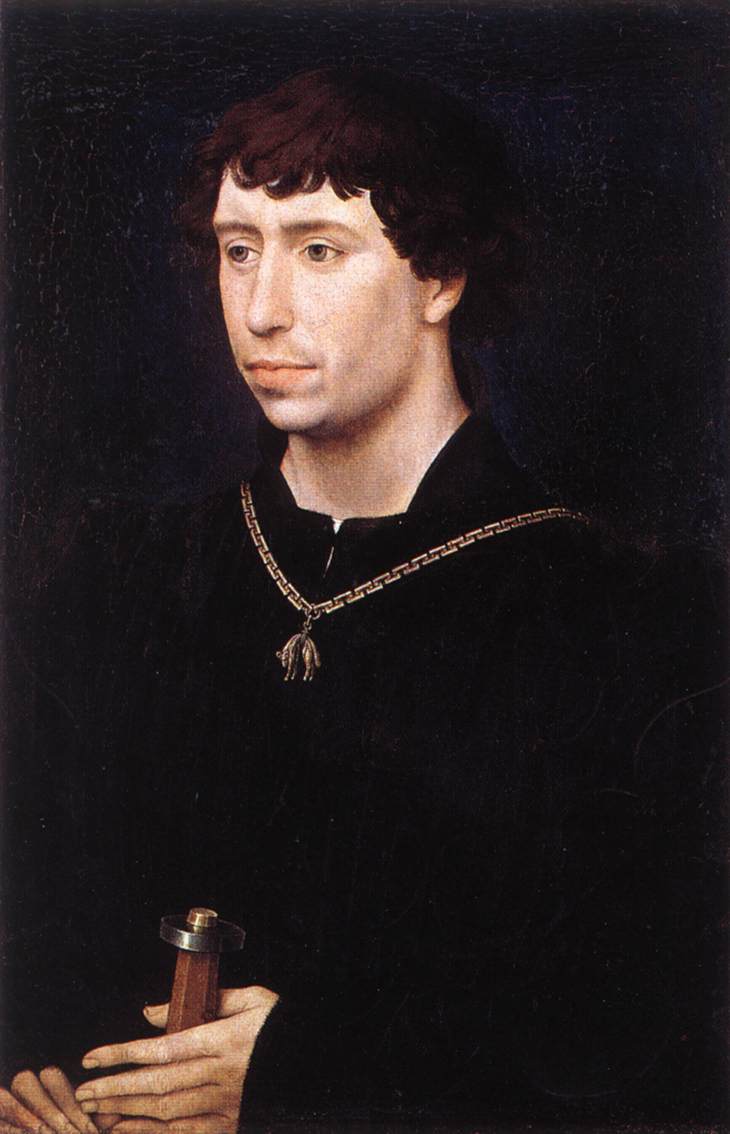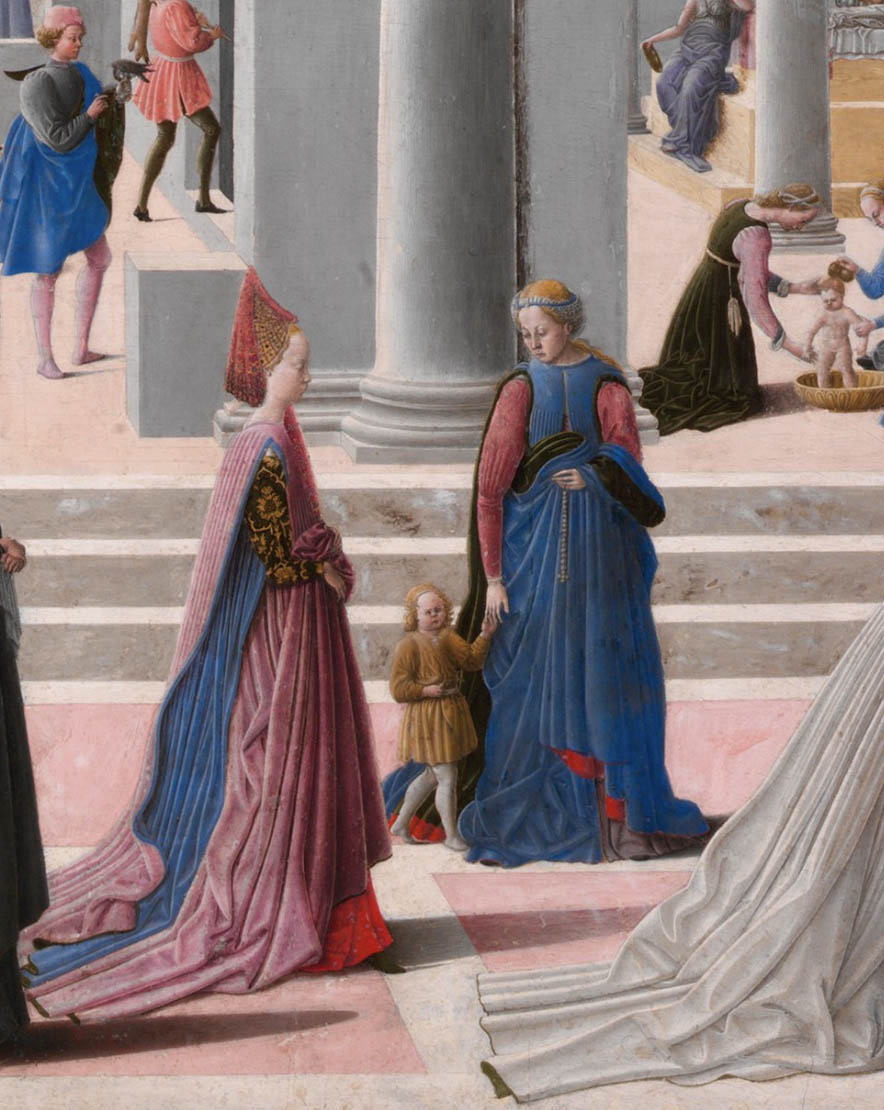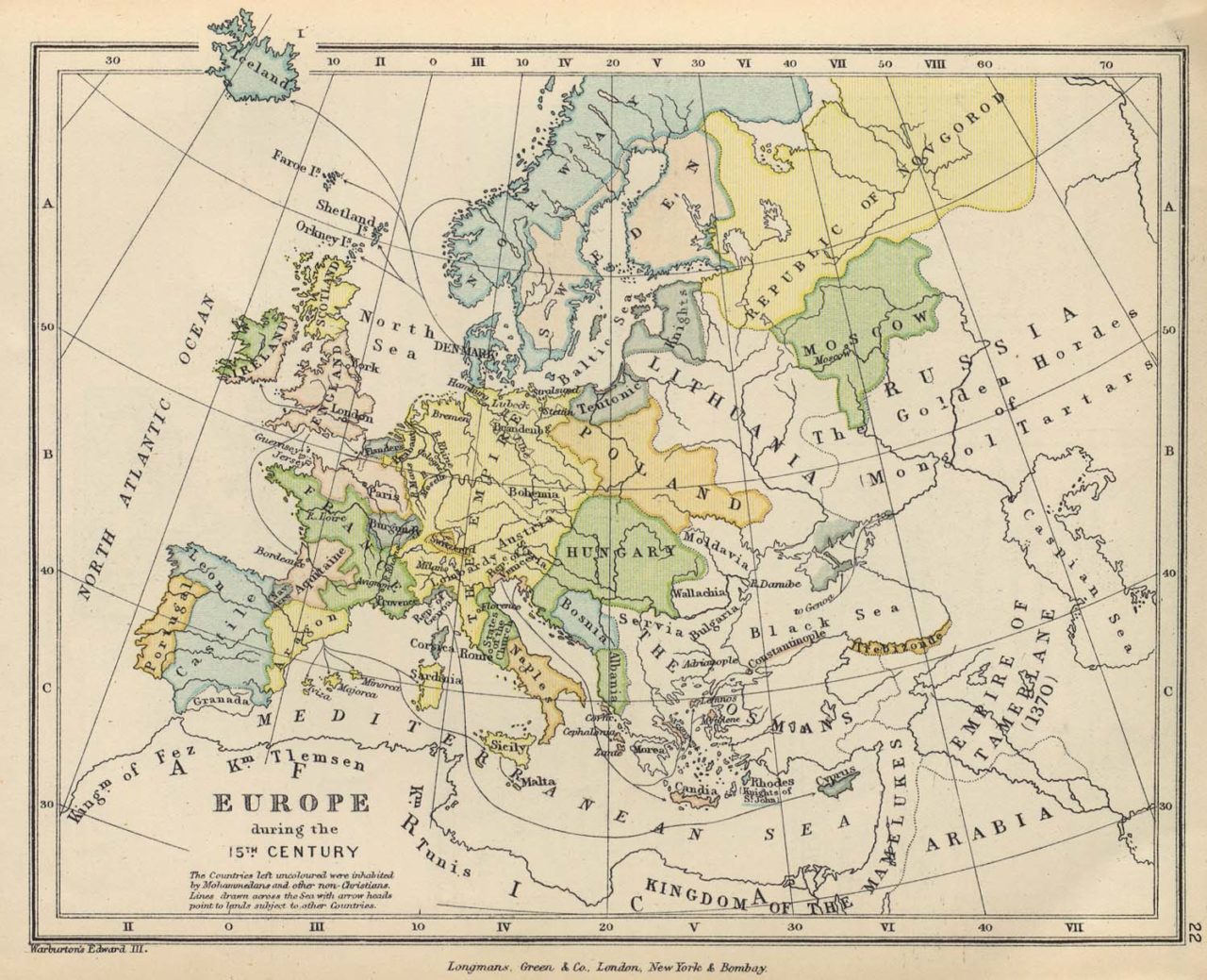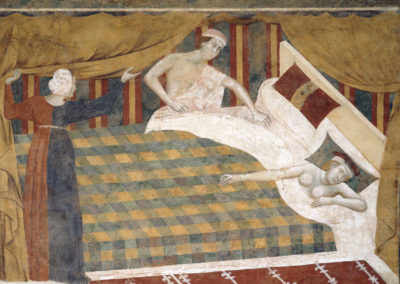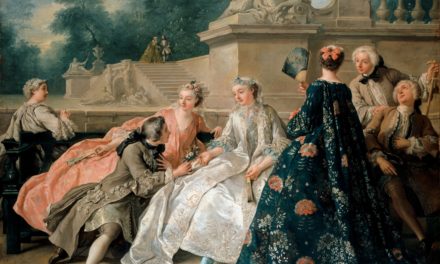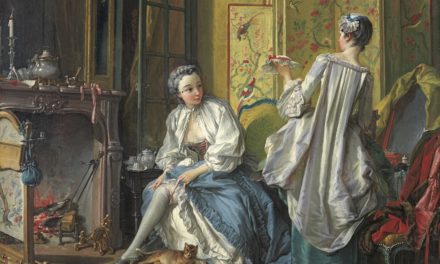OVERVIEW
During the 1460s the differences between the fashions of Italy and those of northern Europe deepened. At the courts of Burgundy and France, men and women’s silhouettes were elongated and angular, from the tops of women’s conical headdresses to the points of men’s poulaine shoes. In Italy, inspired by the art and dress of antiquity, more naturalistic proportions and flowing drapery prevailed.
Womenswear
The chemise of undyed linen continued to be the basic undergarment of all women (Boucher 445). Over it they wore a dress of wool or silk, which in Italy was called the gamurra, rarely worn in public without an outer garment over it (Herald 47, Frick 163). In his depiction of The Birth of the Virgin (Fig. 1) Fra Carnevale has set the event in the background of the painting and in the distant past, where the Virgin’s mother Saint Anne reclines in bed, attended by women dressed in ancient drapery; in the foreground, contemporary women are greeting one another in the public street. In between the two narrative planes, in the middle ground of the painting, we see women bathing the baby, dressed only in their gamurre (Fig. 2). Two of these dresses have sleeves in contrasting colors; sleeves were detachable, usually laced rather than sewn on to the bodice of a dress (Frick 158) and were often made of more expensive fabric (Frick 197). The dresses have round necklines and fit the upper body closely, but the skirts are wide and flowing from the belts placed at a high waistline. The young servant coming through the doorway at the right wears a peach-colored gamurra with lavender sleeves, belted at a very high waistline. The skirt of her dress has been tucked up on one side, to reveal her linen chemise, and she is barefoot. Although the dress is contemporary, it has been styled as if it were an ancient Roman tunic. The servant acts as a bridge between biblical times and the here-and-now of the 1460s, in Urbino where this painting was one wing of an altarpiece in the church of Santa Maria della Bella (Metropolitan Museum).
Fig. 1 - Bartolomeo di Giovanni Corradini (Italian, 1420-1484). The Birth of the Virgin, 1467. Tempera and oil on wood; 144.8 x 96.2 cm (57 x 37 7/8 in). New York: Metropolitan Museum of Art, 35.121. Rogers and Gwynne Andrews Funds, 1935. Source: MMA
Fig. 2 - Bartolomeo di Giovanni Corradini (Italian, 1420-1484). Detail from the Birth of the Virgin, 1467. Tempera and oil on wood; 144.8 x 96.2 cm (57 x 37 7/8 in). New York: Metropolitan Museum of Art, 35.121. Rogers and Gwynne Andrews Funds, 1935. Source: MMA
Fig. 3 - Bartolomeo di Giovanni Corradini (Italian, 1420-1484). Detail from the Birth of the Virgin, 1467. Tempera and oil on wood; 144.8 x 96.2 cm (57 x 37 7/8 in). New York: Metropolitan Museum of Art, 35.121. Rogers and Gwynne Andrews Funds, 1935. Source: MMA
Fig. 4 - Antonio Pollaiuolo (Italian, 1429-1498). Portrait of a Young Woman, ca. 1460-65. Oil on poplar; 52.2 x 36.2 cm. Berlin: Gemäldegalerie, Staatliche Museen, 1614. Source: SMB
Fig. 5 - Rogier van der Weyden (Netherlandish, 1400-1464). Portrait of a Lady, ca. 1460. Oil on wood; 34 x 25.5 cm. Washington, DC: National Gallery of Art, 1937.1.44. Andrew Mellon Collection. Source: NGA
Fig. 6 - Petrus Christus (Flemish, 1410-1475). Portrait of a Young Girl, ca. 1470. Oil on wood; 41.8 x 21.6 cm (16 7/16 x 8 1/2 in). Berlin: Gemäldegalerie, Staatliche Museen, 532. Source: SMB
Of these, Grammar and Rhetoric are dressed in outmoded medieval tunics and capes with simple linen veils; Music wears a ceremonial sideless surcote of blue and gold trimmed with ermine, fit for a Queen’s coronation (Scott 109). Astronomy, farthest to the right, also wears a surcote, of plainer brown fabric and with a more angular cut. Were it not for her tall pointed turret, she too would look decidedly old-fashioned, in fourteenth-century attire. Arithmetic wears a more fashionable dress, with a wide low V-neckline, but her padded roll headdress, called a bourrelet in northern Europe (Van Buren and Wieck 296), and also worn by Music, is old-fashioned. Logic and Geometry are more up-to-date, though Geometry’s turret is surmounted by a curved narrow bourrelet, a style of the 1450s. The most fashionable figure is Philosophy. Her blue dress has the right neckline, and the right contrasting trimming with a wide band at the hem. She even makes the right gesture, with her skirt lifted up and held under her left arm. Her golden turret is so high that its point is hidden in the folds of the linen veils, supported by wires, that surmount the entire structure. This style of headdress combines the high, pointed turret with the banner, first seen in the late 1440s (Van Buren and Wieck 172).
Fig. 7 - Possibly Henri de Vulcop (French, active 1450-1485). Miniatures from Boethius, Consolation de philosophie, ca. 1465. Tempera, gold leaf, gold paint, ink. Los Angeles: The J. Paul Getty Museum, Ms. 42 (91.MS.11). Source: Getty
This angular silhouette for women culminating in the pointed turret harmonized with the Late Gothic architecture of northern Europe. It had already emerged in France and Burgundy by the late 1440s, and in the 1460s there were only further refinements. Certainly any woman in this region of Europe who aspired to a fashionable appearance in this decade had to have some form of turret.
The author Pierre Des Gros, using a French term for the turret, mitre, complained in 1464 that:
“the head, which used to be horned and is now mitred in these parts of France … And these mitres are like chimneys … And (another) great abuse is that the more beautiful and young they are, the taller their chimneys.” (Le jardin des nobles, quoted by Van Buren and Wieck, 319)
Besides mitre, another name for the turret was simply haut bonnet, “high bonnet” (Van Buren and Wieck, 319). What is should not be called is hennin, which relates instead to the horn-shaped headdresses of earlier decades (Van Buren and Wieck 317-318).
No account of the fashions of the 1460s should omit an interesting development in Spain, that would have far-reaching consequences. Juana de Avis, the Portuguese Queen Consort of King Enrique IV of Castile, found herself inconveniently pregnant during a prolonged absence from her husband’s side. She had already had one child, a daughter, who was rumored to be illegitimate. In an attempt to disguise her condition, she had hoops inserted into the skirts of her dresses. While she failed to conceal her pregnancy (she gave birth to twin boys in 1468, and the King divorced her in the same year) she succeeded in starting a new fashion, the verdugo or farthingale, that would eventually spread throughout Europe (Boucher 205).
Fashion Icon: Jeanne de Laval, Duchess of Anjou & Lorraine
Fig. 1 - René d'Anjou (French, 1409-1480). Detail of Testing the Helmets, Le Livre des Tournois, ca. 1460. Manuscript. Paris: Bibliothèque Nationale de France, BNF Ms 2695, fol. 68r. Source: Gallica
Fig. 2 - Audinet Stéphani (French). Praying Donor, Wife of Jean des Martins, Chancellor of Provence, ca. 1450-1475. Paris: Musée national du Moyen Âge, Cl. 19271 (Cl. 7616 a, Cl. 7698 a). Source: Musée national du Moyen Âge
During the 1460s France rivaled Burgundy as the greatest center of fashion in northern Europe, but that was no thanks to the new King, Louis XI, who succeeded his father Charles VII in 1461. The courtier and chronicler Philip de Commines complained that Louis dressed “as badly as could be, with a wretched hat different from everyone else’s, with a leaden pilgrim’s hat on it” (quoted by Evans 59), at a time when rulers adorned their hats with jewels (Vaughan 168). Nor was his Queen, Charlotte of Savoy, able to pursue fashion in a public way, since Louis kept her largely confined to the château of Amboise and preoccupied with the education of her daughters (Jansen, 2-3). Meanwhile, Jeanne de Laval, a Breton noblewoman who became the Duchess of Anjou and of Lorraine and Countess of Provence after her marriage in 1454, traveled throughout France holding court with her husband, René I of Anjou, who had retained a royal title from his brief tenure as King of Naples and Sicily.
During this decade “le roi René” and his Queen lived variously in the Loire valley and in Provençe and were great patrons of the arts, especially the art of the book. One of the books made for him in this decade, Le livre des Tournois, is famous for its large miniature paintings in a sophisticated style (Fig. 1 / Evans 61-62). Jeanne appears at the head of her ladies-in-waiting, in a blue dress trimmed with ermine that has all the features of this decade’s fashion. The V-neckline is not only very low but also very wide, causing the partlet to be wider as well. The sleeves of the dress have long flaring cuffs, turned down to cover most of the hand. The ermine trimming that denotes royalty appears again in a wide band at the hem. The dress has a wide belt and a very long train. Although she has ladies-in-waiting to assist, Queen Jeanne lifts the excess length of her dress in front, revealing the pointy toes of her black shoes. Another accessory to note is the necklace of heavy gold links. Seen through the folded linen veils, her high turret is golden also. Although she lived until almost the end of the century, an alabaster sculpture from Jeanne de Laval’s tomb, originally in Aix-en-Provençe and now in the Musée du Moyen-Age in Paris, shows her dressed in the fashions of this decade, wearing a similar dress, necklace, and headdress (Fig. 2).
Menswear
Italian versions of most of these garments can be seen in The Presentation of the Virgin (Fig. 1), another wing of the same altarpiece as The Birth of the Virgin (Fig. 1 in womenswear). In the foreground a group of beggars (Fig. 2) are wearing only their drawers, which in Italy were called mutande (Herald 223). The shirt is visible only as streaks of white under the high necklines of the next garment, the doublet (farsetto) worn by the two young men in the right foreground (Fig. 3). The doublet was quite short, barely reaching the hips; it was joined to a pair of hose (calze) by means of laces (Herald 211-216). The doublet could be made of wool or silk, but the hose was usually made of wool (Frick 167). The short sideless cape (the giornea, Herald 218) worn by the young man in figure 2, belted in the front and allowed to hang freely in back, allows a view of his purplish pink doublet and bright red hose. We can see that the sleeves of the doublet are constructed in two parts, with the upper part cut full and gathered at a seam above the elbow, where it is attached to the fitted lower sleeve. This was a style called “Lombard sleeves,” which continued from earlier decades (Van Buren and Wieck 168).
Fig. 1 - Bartolomeo di Giovanni Corradini (Italian, 1420-1484). The Presentation of the Virgin in the Temple, 1467. Tempera and oil on wood; 146.4 x 96.5 cm. Boston: Museum of Fine Arts, 37.108. Charles Potter Kling Fund. Source: MFA
Fig. 2 - Bartolomeo di Giovanni Corradini (Italian, 1420-1484). Detail of The Presentation of the Virgin in the Temple, 1467. Tempera and oil on wood; 146.4 x 96.5 cm. Boston: Museum of Fine Arts, 37.108. Charles Potter Kling Fund. Source: MFA
Fig. 3 - Bartolomeo di Giovanni Corradini (Italian, 1420-1484). Detail of The Presentation of the Virgin in the Temple, 1467. Tempera and oil on wood; 146.4 x 96.5 cm. Boston: Museum of Fine Arts, 37.108. Charles Potter Kling Fund. Source: MFA
Fig. 4 - Bartolomeo di Giovanni Corradini (Italian, 1420-1484). Detail of The Presentation of the Virgin in the Temple, 1467. Tempera and oil on wood; 146.4 x 96.5 cm. Boston: Museum of Fine Arts, 37.108. Charles Potter Kling Fund. Source: MFA
The young man to the right, leaning against a pillar, also wears a giornea, but his is wider and belted all the way around; his black doublet, with Lombard sleeves, matches his black hose. Some of the men in the background (Fig. 4) wear a long-sleeved outer garment called the cioppa in Italy (Herald 214-215). It could be quite short, well above the knee like these examples, or well below the knee, as in figure 3. The two young men in the right foreground (Fig. 3) are unusual however, because long outer garments were considered appropriate for older men, especially civic officials and members of the professional class (Van Buren and Wieck 178). Long or short, these outer garments were characterized by their regular vertical “pipe pleats” (Van Buren and Wieck 154), that were probably steamed and sewn in place before being released to flow into the garment. As evidenced in women’s fashion, flowing drapery was much appreciated in Italy. Some men wear draped mantles (mantellos, Herald 222), with or without hoods, instead of or in addition to their outer garments (Figs. 2, 4). The two men in the right foreground are wearing red chaperons (cappucios, Herald 212), headdresses made of draped fabric, thrown over their shoulders for an additional flourish of drapery, even though they already wear round caps. Most of the men wear soled hose that precludes the need for shoes (Frick 45). In general during the 1460s, the Italian love of bright color and all’antica allusions seen in earlier decades continued.
Fig. 5 - René d'Anjou (French, 1409-1480). Livre des Tournois, ca. 1460. Manuscript. Paris: Bibliothèque Nationale de France, BNF Ms 2695, fol. 3v.. Source: Gallica
Fig. 6 - Rogier van der Weyden (Netherlandish, 1400-1464). Portrait of Francesco d’Este, ca. 1460. Oil on wood; 31.8 x 22.2 cm. New York: The Metropolitan Museum of Art, 32.100.43. Bequest of Michael Friedsam, 1931,. Source: MMA
Fig. 7 - Rogier van der Weyden (Netherlandish, 1400-1464). Portrait of Charles the Bold (as Count of Charolais), ca. 1460. Oil on oak; 49 x 32 cm. Berlin: Gemäldegalerie, Staatliche Museen zu Berlin, 545. Source: Wikimedia Commons
Men’s fashion presented a very different picture north of the Alps, where France and Burgundy set the styles. Le Livre des Tournois (Fig. 5) reveals a silhouette characterized by extremely wide shoulders, created by adding padding to the doublet, including cushions called maheutres (Van Buren and Wieck 311). These were not new in the 1460s but the disproportion between a man’s upper and lower body was more extreme. Men’s outer garments, which derive from the houppelandes and haincelins of earlier decades and correspond to the cioppa seen in Italy, are now so short that they can hardly be called by their earlier names, and fashion historians resort to the word “gown” (Van Buren and Wieck 178, 306). Poulaines, the pointy shoes with tips reinforced by wood or bone (Van Buren and Wieck 314) that had been fashionable in northern Europe for most of the century, are as extreme as ever in this decade. At the other extremity the body is also getting pointier. The soft caps that men wear indoors have grown taller and conical; these men here have removed their outdoor hats of wool or fur to show respect.
The only aspect of men’s fashion in France and Burgundy during this decade that seems to align with trends in Italy is the longer, more natural hairstyle, as seen in the portrait of an Italian who was educated at the Burgundian court. Francesco d’Este (Fig. 6) was the natural son of Leonello d’Este, Marquis of Ferrara, and a close friend of Charles, Count of Charolais, the heir to Duke Philip the Good (Vaughan 165). In his portrait by Rogier van der Weyden (Fig. 6), completed circa 1460, he wears a red doublet under a black outer garment trimmed in white. In between the two garments is a gold necklace. The hammer and ring might be related to tournaments, where hammers were used to test helmets and shields, and rings were given as prizes to the victor (Metropolitan Museum). Francesco’s hairstyle is a good example of the newly fashionable à fenêtre or “window” cut, curling over the ears, with bangs across the forehead (Van Buren and Wieck 198). Around the same time, van der Weyden portrayed Charles (Fig. 7) dressed in Burgundian black, relieved only by glimpses of his white shirt and by the collar of the Golden Fleece. His tousled hair is in the `a fenêtre style. Charles became Duke of Burgundy in June 1467 when his father died. The simplicity and modesty displayed in this portrait would be belied by his behavior as Duke, when he would be given over to “sartorial extravagance” (Vaughan 169). In the next decade, he would lead fashion in Burgundy to even greater extremes.
CHILDREN’S WEAR
Fig. 1 - Bartolomeo di Giovanni Corradini (Italian, 1420-1484). Detail from the Birth of the Virgin, 1467. Tempera and oil on wood; 144.8 x 96.2 cm (57 x 37 7/8 in). New York: Metropolitan Museum of Art, 35.121. Rogers and Gwynne Andrews Funds, 1935. Source: MMA
Young children in this decade continued to be dressed in loose-fitting tunics of linen and wool, that could be worn in layers according to the season. An example is seen in figure 1, where a woman in a blue cioppa leads a young boy by the hand. He wears a knee-length tunic and white hose. Girls’ tunics were longer, but not as long as the garments of adult women that trailed on the ground. As they grew older children were dressed more and more like adults, sometimes with the addition of a linen apron or smock to protect fine clothing from damage (Frick 164).
References:
- Boucher, François. 20,000 Years of Fashion: The History of Costume in the West. New York: Abrams, 1987. http://www.worldcat.org/oclc/824293869.
- Evans, Joan. Dress in Medieval France. Oxford: Clarendon Press, 1952. http://www.worldcat.org/oclc/939659457.
- Frick, Carole Collier. Dressing Renaissance Florence: Families, Fortunes and Fine Clothing. Baltimore: Johns Hopkins U Press, 2002. http://www.worldcat.org/oclc/62133195.
- Herald, Jacqueline. Renaissance Dress in Italy, 1400-1500. London: Bell & Hyman, 1981. http://www.worldcat.org/oclc/492385048.
- Jansen, Sharon L. Anne of France: Lessons For My Daughter, ed. Jane Chance. Woodbridge [UK]: Boydell and Brewer, 2004. http://www.worldcat.org/oclc/1075863036.
- Metropolitan Museum of Art, “Portrait of Francesco d’Este,” https://www.metmuseum.org/art/collection/search/437487.
- Monnas, Lisa. Merchants, Princes and Painters: Silk Fabrics in Italian and Northern Paintings 1300-1550. New Haven: Yale University Press, 2008. http://www.worldcat.org/oclc/442203691.
- National Gallery of Art, Washington, D.C. “Rogier van der Weyden, Portrait of a Lady, c. 1460.” https://www.nga.gov/collection/art-object-page.51.html.
- Scott, Margaret. Fashion in the Middle Ages. Los Angeles: J. Paul Getty Museum, 2011. http://www.worldcat.org/oclc/756230586.
- Van Buren, Anne and Roger S. Wieck. Illuminating Fashion: Dress in the Art of Medieval France and the Netherlands. New York: Pierpont Morgan Library, 2011. http://www.worldcat.org/oclc/742330843.
- Vaughan, Richard. Charles the Bold: The Last Valois Duke of Burgundy. Vol. 4 of The Dukes of Burgundy. Woodbridge [UK]: Boydell Press, 2002. http://www.worldcat.org/oclc/469482151.
Historical Context
Wikipedia: 1460-1469
Rulers:
- France
- King Charles VII (1422-1461)
- King Louis XI (1461-1483)
- England
- King Henry VI (1422-1461)
- King Edward IV (1461-1470)
- Spain
- King Henry IV of Castile (1462-1463)
- King Peter V of Aragon (1463-1466)
Europe during the 15th Century. Source: University of Texas Libraries
Events:
- 1461 – Battle of Towton: Edward IV defeats Queen Margaret, to make good his claim to the English throne (thought to be the bloodiest battle ever fought in England).
- 1466 – Louis XI of France introduces silk weaving to Lyon
- 1469 – Ferdinand and Isabella united Spain
Timeline Entries
Primary/Period Sources
Resources for Fashion History Research
To discover primary/period sources, explore the categories below.
Have a primary source to suggest? Or a newly digitized periodical/book to announce? Contact us!
Digitized Primary/Period Sources
Secondary Sources
Also see the 15th-century overview page for more research sources… or browse our Zotero library.

